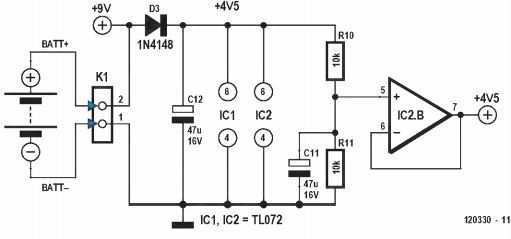The Wien bridge oscillator circuit generates a low-distortion sine wave of steady amplitude that ranges from 15 Hz to 150 kHz. It needs just four op-amps and can be powered from just a 9 V battery.
Moreover, this device is quite distinct compared to conventional Wien bridge oscillators because it does not necessitate a dual-gang potentiometer for tuning.
Circuit Description
Op-amp IC2b delivers an artificial ground so that the circuit will function from a unipolar supply (the 9 V battery or a power pack). IC2a works as the main amplifier for the oscillator. The frequency range is split into four decades by a 2-pole, 4-way rotary switch, SW1.

There can be only one arm in the Wien bridge network to have a different configuration. However, the change in the positive feedback that would typically happen is returned for by IC1b, hence bootstrapping R2.
As a result, the negative feedback will be modified just enough to sustain oscillation. A linear variation in the resistance of the tuning pot produces a coarse logarithmic change in frequency. If you need to obtain a more linear change, a log-taper pot must be included.
This action rotates the knob counterclockwise which boosts the frequency. Another possibility of using the anti-log pot is by turning it around but since these parts are difficult to find it’s best to stick with the suggested configuration.
IC1a works as an integrator that supervises the amplitude of the output signal and powers an LED (D2).
This part must be attached facing the LDR (Light Dependent Resistor) and protected from ambient light using materials like heat shrink tubes. Then, the IC would be able to regulate the gain of IC2a which warrants steady oscillation with very minimal distortion.
The peak output amplitude of the generator is around 2 Vp-p when the LED and LDR are fixed as close as possible.
Furthermore, distortion is greatly reduced (less than 0.5%) in the lowest range and quite low to measure at higher ranges. You may pick any LDR type as long as its dark resistance is more than 100 kΩ.
In case you do not possess such LDR, attempt to ramp up the resistance of R5 until the oscillation begins. This circuit was constructed on a breadboard as a prototype using dual and quad op-amp packages. Both performed well.
9 V to 4.5 V Converter for the above wien bridge oscillator circuit

Leave a Reply